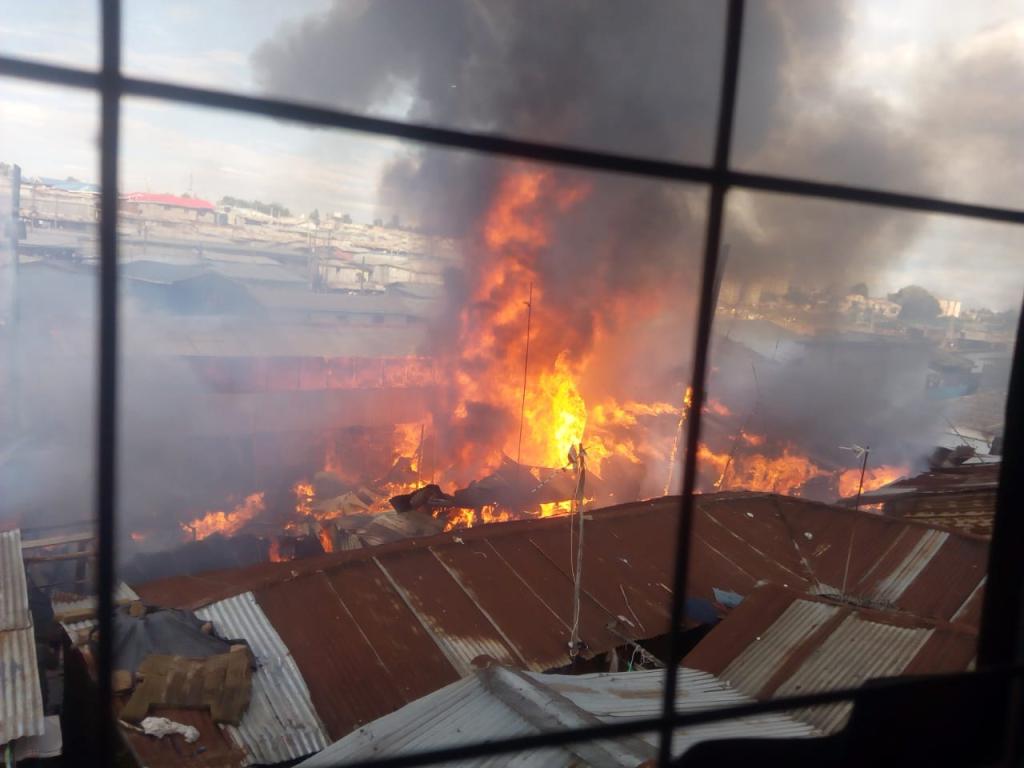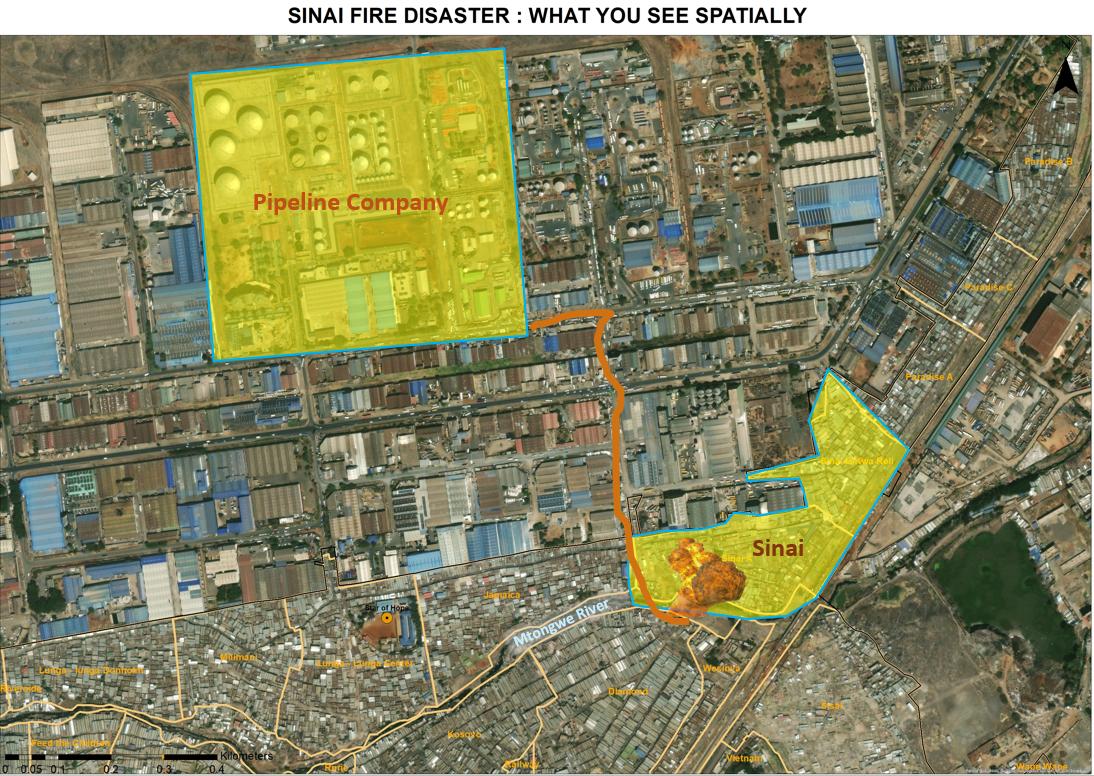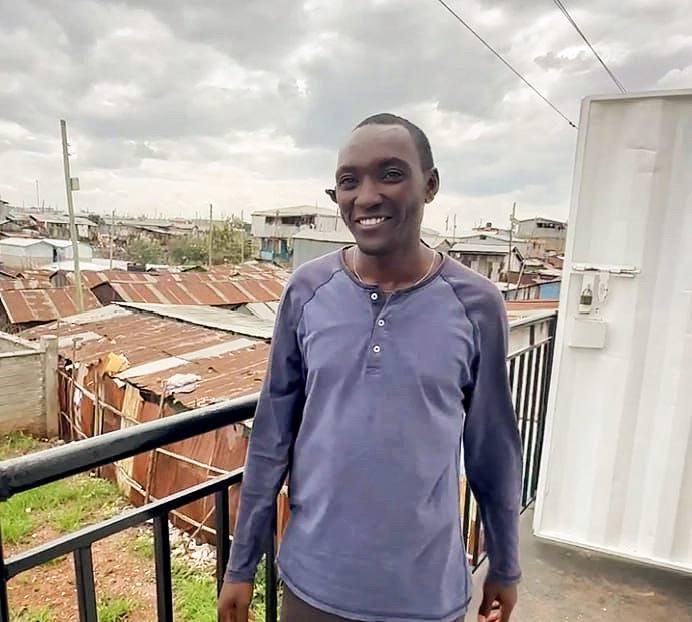Article by Beatrice Hati Gitundu and Francis Mukiri

You might gaze at this image and think, “If only the photographer had been a little more creative and had reached beyond the mesh, we would have gotten a clearer view of the fire.” Yet we, as the authors of this article, cannot help but appreciate how beautifully it portrays the complex essence of fire disasters, perceptible only when one looks ‘beneath the surface’. In contested spaces like ghettos, a fire disaster is not just a physical occurrence; it is a socio-politically intertwined phenomenon laden with dynamic micropatterns that shape the interpretations and subsequent responses to such disasters. In this article, Beatrice Gitundu and Future (Francis Mukiri) discuss how fire disasters in Nairobi’s ghettos are navigated, hoping to provoke a deeper comprehension of the multiple ontologies of fire disasters and how these can inform disaster risk governance in ghettos.
As you read this article, you’ve likely encountered a fire today, whether in preparing a warm meal, savouring a barbecue, or simply lighting a candle or a cigarette. For many, fire is an intuitive part of human life — a simple flick of a match or the flip of a switch to give us a flame for our daily use.
However, for the over one billion people living in ghettos (1) worldwide, a fire transcends these simple, intuitive meanings. Here, fires pose an everyday threat, often intersecting with multiple vulnerabilities to cause devastating fire disasters. Fire disasters in turn can lead to severe injury, deep psychological trauma, extensive property damage, the loss of lives, degraded ecological health, and enduring impacts on lives and livelihoods. Given their ubiquity, pervasiveness, and intricate interaction with city and community systems, there is more to a fire disaster than meets the eye.
In this article, we use an illustrative example of Nairobi’s 2011 pipeline fire to discuss multiple ontologies inherent in a (fire) disaster and the implications for disaster governance in ghettos. So, pull up a chair and kahawa as this blog takes you on a journey through the deeply ingrained layers of fire disasters, exploring what such layering can tell us about interpretation and governance of (fire) disasters. While our insights draw from immersive engagements with a network of community firefighters in Nairobi’s ghettos called the GRO6, the challenges to understanding and adequately managing (fire) disasters transcends regional borders.
Reconstructing and recounting the events
The observations here are based on two mobile theatre sessions co-organized with GRO6 on 8 and 9 November last year. These sessions form part of a broader series of methods used by Beatrice for conducting her PhD research, which examines multi-level disaster governance arrangements at the grassroots level through a case study of fire disaster management in the ghettos. During these sessions, members of grassroots organizations from Mukuru (including victims and emergency responders like co-author Future) recounted their real-life experiences of the disaster in Sinai. The narratives were enriched by participatory actor mapping and an on-site fire demo, where GRO6 and residents in the now-rebuilt area of Sinai not only recounted the events of the day but also showcased localized fire safety strategies that emerged afterwards. The observations from the mobile theatres are enhanced by expert narratives compiled from Beatrice’s interviews with fire administrators between January and March 2024, as well as from pre-existing interviews from secondary data sources.
The disaster: from “foretold hellfire to” “industrial accident”
On the rainy morning of 12 September 2011, what was to be a typical Monday for the residents of the Nairobi ghetto Mukuru Sinai turned tragic. A deafening explosion was heard, followed by a raging fire that razed through the ghetto, reducing over 400 homes to ashes and claiming more than 120 lives. An oil pipeline carrying lethal super petrol from a nearby oil depot had spilled large amounts of petrol into the storm water drainage system and the river flowing through Mukuru, which was ignited, causing an explosion.

This fire disaster was seen through various lenses. Sinai residents described the fire vividly as a “rolling fireball”, a “burning river of death”, “the foretold hellfire”, “Black November” (an oil exploitation movie), “the walking dead”, and in other ways. Future, one of this article’s authors, describes the aftermath as “[…] a harrowing experience that transformed the beautiful Sinai into a field punctuated by death cries and drenched in blood, leaving lasting physical, mental, emotional, and financial scars that continue to undermine the residents’ resilience.”
For the privileged elite, on the other hand, the disaster was merely an accidental oil spillage. In its press release (Annex IV), the oil company attributed the fire disaster to a technical fault and denied any responsibility for the ‘accident’ caused by the spillage. Civil society actors on the other hand saw it as a crisis of enforcement, as a penalty paid by the impoverished for living there illegally, or as the deprioritization of ghettos by state agencies and the private sector as a result of corruption.
Civil society actors were actively responsive, with agencies like the Kenya Red Cross engaging in complementary search and rescue/recovery operations and emergency relief distribution. Others formed coalitions and engaged in legal contestation and collective advocacy through CSO statements aimed at holding the government and the pipeline company accountable. Additionally, UNEP and UN-OCHA conducted emergency environmental assessments to determine the ‘actual’ cause of the fire and inform policy decisions. They deemed the disaster an “industrial accident”. Post-disaster psychological first aid (PFA) was offered, albeit temporarily, which grassroots organizations criticized as a ‘hit-and-run’ response.
Politicians framed it in different ways, for example as the harsh cost of the pervasive encroachment on riparian reserves by illegal squatters or as a tragedy caused by systemic failures which were confronted politically and legally by the area’s Member of Parliament. Meanwhile, the media portrayed the disaster as a recurring ‘lesson never learnt’. This observation is especially poignant following the Embakasi fire tragedy in February this year — nearly 13 years later — that, like the Sinai pipeline fire, led to the loss of homes, lives, and dignity.
What lies beneath the flames?
These interpretations reveal the complexity of fire disasters, illustrating the interconnectedness of (such) disasters with place-based socio-cultural, political, religious, and economic systems. The Sinai disaster embodied multiple fire ontologies (2) that impacted how the disaster was governed and understood during and after it happened. The engagements during the mobile theatres and a critical analysis of supplementary data point to three fire ontologies with different undertones:
- Reinforced exploitation
Two significant trends set the stage for this ontology. The first was the recurring incidence of oil spills in the Mtongwe River (Ngong River). Every now and then, oil products would find their way into the river due to leaks or the vandalism of pipelines to access the precious commodity. Residents would scavenge for leaked oil. The second was the rampant practice of illegal oil siphoning — a lucrative business linked to business and political elites. The grassroots organizations revealed how this illegal business was camouflaged using exhauster trucks to transport siphoned oil. Youth got involved for profit, interpreting it as a “once-in-a-lifetime, God-given opportunity.”
This illustrates how oil siphoning has been socialized as a means of survival, how poverty drives the urban poor into perilous ventures, how the oil black market becomes politicized, and how capitalism perpetuates risk. The absence of alternative livelihood opportunities coupled with what Aiyabei et al. describe as the failure of enforcement created a fertile ground for continued exploitation of desperate residents. Ghetto residents considered taking the risk as better than unemployment, while the affluent in the oil market ‘industry’ exploited cheap labour whilst remaining hidden.
- Systemic failure
Multiple systemic failures were seen as gradually having reproduced the disaster. From absence of proper environmental and social impact assessments to a lack of planning, a lack of decent livelihood opportunities, the political facilitation of illegal siphoning, and weakened community vigilance, we see multiple factors converging over time to facilitate the tragedy. Narratives of illegality of the Sinai neighbourhood deflected attention from these contributing factors. “In the first place, it was even illegal to put up houses there. Where were we? We should have enforced the law,” remarked one civil society actor in a documentary (21:32). The ontology of ‘fires as a failure of systems’ hereby discounts the direct association of disaster risk solely with the illegality and unplanned nature of ghettos, emphasizing instead the need to look beneath the surface at the other underlying factors that mediate the occurrence and severity of a disaster.
3. Disaster bias
When a fire, especially a ghetto fire, is pitted against the myriad competing needs in cities, it never seems to make the cut. In Sinai, promised compensation and recovery investments were not fulfilled. In contrast, fires affecting the upper echelons of society, such as those at the city’s mall and airport, garnered immediate and substantial political attention, leading to generous resource allocation and the epoch-marking establishment of a national unit mandated to coordinate disaster management efforts. As one expert mentioned, “[…] two events that happened in Kenya during that year [2013] informed the decision by the then president to direct the establishment of a unit, and with a mandate and functions and vision, mission, and all that.”
These patterns underscore how economic and political influence shape the hierarchy of disasters, with some being perceived as more serious and others trivial. This (de)prioritization of disasters attracts varying levels of attention, responses, and resource allocation. It also raises the question: Why isn’t fire considered a good-enough disaster? While some speculate that fires generally rank lower on the disaster hierarchy, the reality reveals an interplay of power and politics that perpetuates disaster risk.
Oversimplified understandings yield oversimplified responses
Probing the underlying contingencies that give a disaster its ontology is essential for understanding how the disaster is interpreted and consequently addressed. Despite the Sinai fire tragedy having been formally categorized as an industrial accident, the narratives analyzed here indicate complexities that go beyond the assumed spatial, temporal, and stakeholder boundaries of the disaster. The limited attention to exploitative patterns, systemic failures, and disaster biases constrained the development and implementation of comprehensive fire disaster management strategies before, during, and after the fire disaster. Oversimplifying disasters as single, isolated physical incidents overlooks their intricate interconnectedness with society, politics, economics, culture, beliefs, religions, and other factors. This ontological analysis lays emphasis on understanding the disaster in its multiple realities, boundaries, and interactions as an important foundation for effective disaster governance.
There is therefore an urgent need for Nairobi County’s disaster risk reduction department (DRR), the Kenya Red Cross Society, and other pertinent agencies to revisit the Sinai Tragedy. This entails not only fostering meaningful fire disaster resilience in Mukuru Sinai but also rethinking and collaboratively designing an approach to incorporate fire ontologies into fire disaster management practices. Enhanced an understanding of the multiple ontologies of fires can further bolster the efforts of frontline fire responders such as the Nairobi Fire Rescue Services (FRS) and community firefighters, including those in GRO6 and the Africa Fire Mission.
We continue engaging with GRO6, a grassroots network of community firefighters in the Mathare, Mukuru and Kibera Ghettos.
End notes:
(1)The term “ghetto” is used by communities is the so-called ‘informal settlements’ of Nairobi to refer to their homes. Therefore, this lexicon is adopted here to the extent necessary to uphold the indigenous nomenclature.
(2) Goodall et al. broadly describe ontologies in disaster sciences as the “philosophy of reality”, simplified as exploring the existence of a phenomenon (such as a fire) through the realms of underlying meanings, beliefs, and values that may be intuitive, assumed, and/or debated.
About the authors
 Beatrice Hati is a pracademic specializing in people-centered urbanism and resilience. She currently pursues a doctoral degree in multilevel disaster governance at the ISS while simultaneously serving as an urban development and research associate at the International Centre for Frugal Innovation (Kenya Hub).
Beatrice Hati is a pracademic specializing in people-centered urbanism and resilience. She currently pursues a doctoral degree in multilevel disaster governance at the ISS while simultaneously serving as an urban development and research associate at the International Centre for Frugal Innovation (Kenya Hub).
 Francis Mukiri (Future)is a community resilience advocate, a community firefighter, and leader of a grassroots organization in the Mukuru Ghettos.
Francis Mukiri (Future)is a community resilience advocate, a community firefighter, and leader of a grassroots organization in the Mukuru Ghettos.
